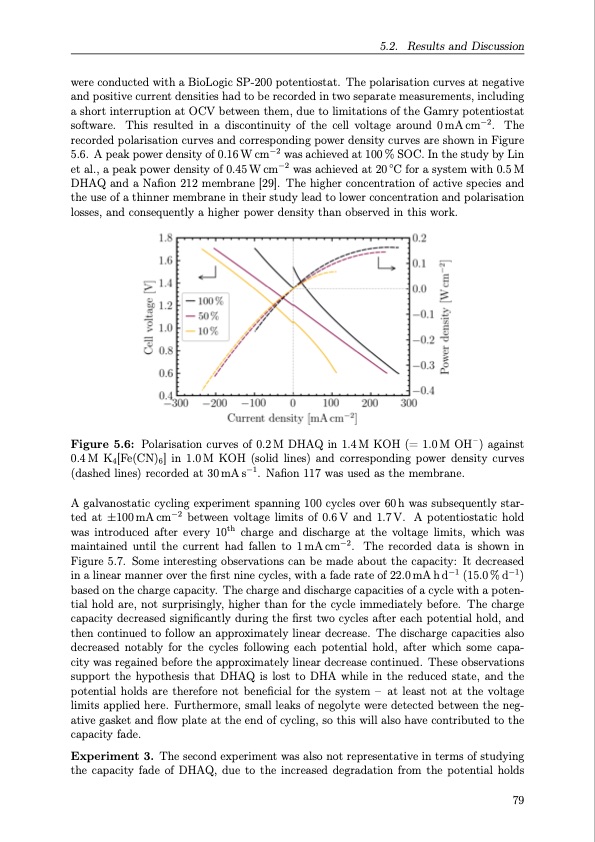
PDF Publication Title:
Text from PDF Page: 100
were conducted with a BioLogic SP-200 potentiostat. The polarisation curves at negative and positive current densities had to be recorded in two separate measurements, including a short interruption at OCV between them, due to limitations of the Gamry potentiostat software. This resulted in a discontinuity of the cell voltage around 0 mA cm−2 . The recorded polarisation curves and corresponding power density curves are shown in Figure 5.6. A peak power density of 0.16 W cm−2 was achieved at 100 % SOC. In the study by Lin et al., a peak power density of 0.45 W cm−2 was achieved at 20 ◦C for a system with 0.5 M DHAQ and a Nafion 212 membrane [29]. The higher concentration of active species and the use of a thinner membrane in their study lead to lower concentration and polarisation losses, and consequently a higher power density than observed in this work. Figure 5.6: Polarisation curves of 0.2M DHAQ in 1.4M KOH (= 1.0M OH–) against 0.4M K4[Fe(CN)6] in 1.0M KOH (solid lines) and corresponding power density curves (dashed lines) recorded at 30 mA s−1. Nafion 117 was used as the membrane. A galvanostatic cycling experiment spanning 100 cycles over 60 h was subsequently star- ted at ±100mAcm−2 between voltage limits of 0.6V and 1.7V. A potentiostatic hold was introduced after every 10th charge and discharge at the voltage limits, which was maintained until the current had fallen to 1 mA cm−2 . The recorded data is shown in Figure 5.7. Some interesting observations can be made about the capacity: It decreased in a linear manner over the first nine cycles, with a fade rate of 22.0 mA h d−1 (15.0 % d−1) based on the charge capacity. The charge and discharge capacities of a cycle with a poten- tial hold are, not surprisingly, higher than for the cycle immediately before. The charge capacity decreased significantly during the first two cycles after each potential hold, and then continued to follow an approximately linear decrease. The discharge capacities also decreased notably for the cycles following each potential hold, after which some capa- city was regained before the approximately linear decrease continued. These observations support the hypothesis that DHAQ is lost to DHA while in the reduced state, and the potential holds are therefore not beneficial for the system – at least not at the voltage limits applied here. Furthermore, small leaks of negolyte were detected between the neg- ative gasket and flow plate at the end of cycling, so this will also have contributed to the capacity fade. Experiment 3. The second experiment was also not representative in terms of studying the capacity fade of DHAQ, due to the increased degradation from the potential holds 5.2. Results and Discussion 79PDF Image | Organic Redox Flow Batteries 2023

PDF Search Title:
Organic Redox Flow Batteries 2023Original File Name Searched:
PhD_thesis_final_dorhoff_4_.pdfDIY PDF Search: Google It | Yahoo | Bing
Salgenx Redox Flow Battery Technology: Salt water flow battery technology with low cost and great energy density that can be used for power storage and thermal storage. Let us de-risk your production using our license. Our aqueous flow battery is less cost than Tesla Megapack and available faster. Redox flow battery. No membrane needed like with Vanadium, or Bromine. Salgenx flow battery
| CONTACT TEL: 608-238-6001 Email: greg@salgenx.com | RSS | AMP |